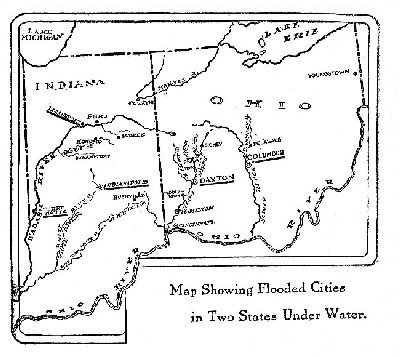"A great mountain of water has been hurled from the clouds upon Ohio," said a graphic writer in the Cleveland Leader on March 27. "A lake has been emptied upon this state.
"The rainfall since Sunday morning must have been not less than six inches, on the average, over the 41,000 odd square miles inside the limits of the commonwealth. That precipitation is indicated by the Cleveland record and other figures from various points.
"Six inches of rain throughout Ohio means about 575,000,000,000 cubic feet of water. That is equivalent to a lake ten feet deep, 80 miles long and 25 miles in average width. It would make a lake 20 feet deep, 40 miles long and 25 miles wide, throughout its length.
"Put this enormous mass of water in another form and it would fill a gigantic standpipe a mile in diameter and about five miles high. It would overflow such an incredible tank towering far above the top of the highest mountain in North America.
"The weight of such a mass of water is monstrous. Roughly speaking—for all statistics of the rainfall in the state must necessarily be general and loosely put together—the rain which has come down in Ohio in three days means about 18,000,000,000 tons.
"That is more than all the coal mined in America since the first pound was taken from the ground. It makes the weight of all the iron ore ever produced in all the world look small by contrast.
"If the water which has been rained down upon Ohio since the present week began could be put in the balance against the products of the farms of the United States it would outweigh all the grain and all the hay of half a century, at the current rate of production, with all the fruit added.
"Inside the city limits of Cleveland, a little patch of ground compared with the area of the state or even the Cuyahoga valley, enough water has fallen in three days to outweigh, by a wide margin, all the iron ore received at this port in the best year lake shipping ever enjoyed, and all the coal shipped. The rainfall in the city has been about equal to a year’s output of the coal mines of Ohio.
"Enough water has fallen inside the municipal limits to make a lake two miles long, a mile wide and ten feet deep. Or it would fill a reservoir fifty feet deep, half a mile wide and only a little less than a mile long.
"Human dams, bridges, levees, walls and other structures have had to meet the force of weights and masses so stupendous that ordinary figures lose their significance by contrast with the water which has flooded Ohio valleys and lowlands."

Four rivers caused the principal flood damage in Ohio and Indiana, as follows:
Miami River—It flows through alluvial valleys in a raised bed, with a slow current and low banks. Rising on the low watershed in the central district of Ohio, it flows past Hamilton, Dayton, Troy, Piqua, Sidney, Middletown, Miamisburg and other busy cities, all heavy sufferers from the flood. It empties into the Ohio at the southwest corner of the state, at the Indiana line.
Scioto River—It rises in the central watershed of the state of Ohio and enters the Ohio river at Portsmouth. Columbus, Circleville and Chillicothe are also situated on its banks. Of these cities Columbus was the chief sufferer.
Wabash River—It rises in the Ohio watershed and soon flows into Indiana. Among the many cities on its banks, Peru, sixteen miles east of Logansport, suffered most. Terre Haute, also a heavy sufferer from recent storms and from the tornado that struck it Sunday afternoon, March 23, was hurt by the flood in the river section. Lafayette was partially submerged.
White River—A tributary of the Wabash. The west fork of this river caused the great losses in West Indianapolis.
These southward flowing rivers, situated in a rich, level agricultural country and yet having on their banks cities swarming with profitable manufactories which have grown up because of the splendid transportation, cheap coal and natural gas, were gorged by torrential rains falling in a broad, deforested section of highly cultivated and tilled farm lands, so that the runoff was immediate. Thus the floods came with terrible suddenness, drowning many almost before they had realized their peril.
Continue
Back
Back to Legacy
© 2001, Lynn Waterman